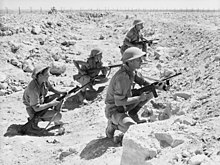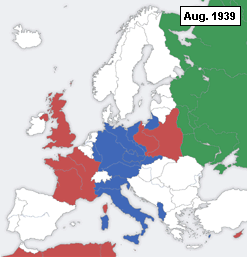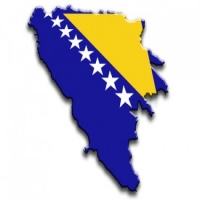![]() Published in Georgia - Social interactions and entertainment - 10 Jun 2016 03:57 - 4
Published in Georgia - Social interactions and entertainment - 10 Jun 2016 03:57 - 4
Mediterranean (1940–41)
Italy began operations in the Mediterranean, initiating a siege of Malta in June, conquering British Somaliland in August, and making an incursion into British-held Egypt in September 1940. In October 1940, Italy started the Greco-Italian War because of Mussolini's jealousy of Hitler's success but within days was repulsed and pushed back into Albania, where a stalemate soon occurred. The United Kingdom responded to Greek requests for istance by sending troops to Crete and providing air support to Greece. Hitler decided that when the weather improved he would take action against Greece to ist the Italians and prevent the British from gaining a foothold in the Balkans, to strike against the British naval dominance of the Mediterranean, and to secure his hold on Romanian oil.In December 1940, British Commonwealth forces began counter-offensives against Italian forces in Egypt and Italian East Africa. The offensive in North Africa was highly successful and by early February 1941 Italy had lost control of eastern Libya and large numbers of Italian troops had been taken prisoner. The Italian Navy also suffered significant defeats, with the Royal Navy putting three Italian battleships out of commission by a carrier attack at Taranto, and neutralising several more warships at the Battle of Cape Matapan. Australian troops of the British Commonwealth Forces man a front-line trench during the Siege of Tobruk;North African Campaign, August 1941
Australian troops of the British Commonwealth Forces man a front-line trench during the Siege of Tobruk;North African Campaign, August 1941
The Germans soon intervened to ist Italy. Hitler sent German forces to Libya in February, and by the end of March they had launched an offensive which drove back the Commonwealth forces which had been weakened to support Greece. In under a month, Commonwealth forces were pushed back into Egypt with the exception of the besieged port of Tobruk. The Commonwealth attempted to dislodge Axis forces in May and again in June, but failed on both occasions.By late March 1941, following Bulgaria's signing of the Tripartite Pact, the Germans were in position to intervene in Greece. Plans were changed, however, because of developments in neighbouring Yugoslavia. The Yugoslav government had signed the Tripartite Pact on 25 March, only to be overthrown two days later by a British-encouraged coup. Hitler viewed the new regime as hostile and immediately decided to eliminate it. On 6 April Germany simultaneously invaded both Yugoslavia and Greece, making rapid progress and forcing both nations to surrender within the month. The British were driven from the Balkans after Germany conquered the Greek island of Crete by the end of May. Although the Axis victory was swift, bitter partisan warfare subsequently broke out against the Axis occupation of Yugoslavia, which continued until the end of the war.The Allies did have some successes during this time. In the Middle East, Commonwealth forces first quashed an uprising in Iraq which had been supported by German aircraft from bases within Vichy-controlled Syria, then, with the istance of the Free French, invaded Syria and Lebanon to prevent further such occurrences..
Axis attack on the USSR (1941)
With the situation in Europe and Asia relatively stable, Germany, Japan, and the Soviet Union made preparations. With the Soviets wary of mounting tensions with Germany and the Japanese planning to take advantage of the European War by seizing resource-rich European possessions in Southeast Asia, the two powers signed the Soviet–Japanese Neutrality Pact in April 1941. By contrast, the Germans were steadily making preparations for an attack on the Soviet Union, ming forces on the Soviet border.Hitler believed that Britain's refusal to end the war was based on the hope that the United States and the Soviet Union would enter the war against Germany sooner or later. He therefore decided to try to strengthen Germany's relations with the Soviets, or failing that, to attack and eliminate them as a factor. In November 1940, negotiations took place to determine if the Soviet Union would join the Tripartite Pact. The Soviets showed some interest, but asked for concessions from Finland, Bulgaria, Turkey, and Japan that Germany considered unacceptable. On 18 December 1940, Hitler issued the directive to prepare for an invasion of the Soviet Union.On 22 June 1941, Germany, supported by Italy and Romania, invaded the Soviet Union in Operation Barbarossa, with Germany accusing the Soviets of plotting against them. They were joined shortly by Finland and Hungary. The primary targets of this surprise offensive were the Baltic region, Moscow and Ukraine, with the ultimate goal of ending the 1941 campaign near theArkhangelsk-Astrakhan line, from the Caspian to the White Seas. Hitler's objectives were to eliminate the Soviet Union as a military power, exterminate Communism, generate Lebensraum ("living space") by dispossessing the native lation and guarantee access to the strategic resources needed to defeat Germany's remaining rivals.Although the Red Army was preparing for strategic counter-offensives before the war, Barbarossa forced the Soviet supreme command to adopt a strategic defence. During the summer, the Axis made significant gains into Soviet territory, inflicting immense losses in both personnel and materiel. By the middle of August, however, the German Army High Command decided to suspend the offensive of a considerably depleted Army Group Centre, and to divert the 2nd Panzer Group to reinforce troops advancing towards central Ukraine and Leningrad. The Kiev offensive was overwhelmingly successful, resulting in encirclement and elimination of four Soviet armies, and made further advance into Crimea and industrially developed Eastern Ukraine (the First Battle of Kharkov) possible.The diversion of three quarters of the Axis troops and the majority of their air forces from France and the central Mediterranean to theEastern Front prompted Britain to reconsider its grand strategy. In July, the UK and the Soviet Union formed a military alliance against Germany The British and Soviets invaded Iran to secure the Persian Corridor and Iran's oil fields. In August, the United Kingdom and the United States jointly issued the Atlantic Charter.By October Axis operational objectives in Ukraine and the Baltic region were achieved, with only the sieges of Leningrad andSevastopol continuing. A major offensive against Moscow was renewed; after two months of fierce battles in increasingly harsh weather the German army almost reached the outer suburbs of Moscow, where the exhausted troops were forced to suspend their offensive. Large territorial gains were made by Axis forces, but their campaign had failed to achieve its main objectives: two key cities remained in Soviet hands, the Soviet capability to resist was not broken, and the Soviet Union retained a considerable part of its military potential. The blitzkrieg phase of the war in Europe had ended.By early December, freshly mobilised reserves allowed the Soviets to achieve numerical parity with Axis troops. This, as well as intelligence data which established that a minimal number of Soviet troops in the East would be sufficient to deter any attack by the Japanese Kwantung Army, allowed the Soviets to begin a mive counter-offensivethat started on 5 December all along the front and pushed German troops 100–250 kilometres (62–155 mi) west.

War breaks out in the Pacific (1941)
In 1939 the United States had renounced its trade treaty with Japan and beginning with an aviation gasoline ban in July 1940 Japan had become subject to increasing economic pressure. During this time, Japan launched its first attack against Changsha, a strategically important Chinese city, but was repulsed by late September. Despite several offensives by both sides, the war between China and Japan was stalemated by 1940. To increase pressure on China by blocking supply routes, and to better position Japanese forces in the event of a war with the Western powers, Japan invaded and occupied northern Indochina. Afterwards, the United States embargoediron, steel and mechanical parts against Japan. Other sanctions soon followed.In August of that year, Chinese communists launched an offensive in Central China; in retaliation, Japan instituted harsh measures in occupied areas to reduce human and material resources for the communists. Continued antipathy between Chinese communist and nationalist forces culminated in armed clashes in January 1941, effectively ending their co-operation. In March, the Japanese 11th army attacked the headquarters of the Chinese 19th army but was repulsed during Battle of Shanggao. In September, Japan attempted to take the city of Changsha again and clashed with Chinese nationalist forces.German successes in Europe encouraged Japan to increase pressure on European governments in Southeast Asia. The Dutch government agreed to provide Japan some oil supplies from the Dutch East Indies, but negotiations for additional access to their resources ended in failure in June 1941. In July 1941 Japan sent troops to southern Indochina, thus threatening British and Dutch possessions in the Far East. The United States, United Kingdom and other Western governments reacted to this move with a freeze on Japanese ets and a total oil embargo.Since early 1941 the United States and Japan had been engaged in negotiations in an attempt to improve their strained relations and end the war in China. During these negotiations Japan advanced a number of proposals which were dismissed by the Americans as inadequate. At the same time the US, Britain, and the Netherlands engaged in secret discussions for the joint defence of their territories, in the event of a Japanese attack against any of them. Roosevelt reinforced the Philippines (an American protectorate scheduled for independence in 1946) and warned Japan that the US would react to Japanese attacks against any "neighboring countries". Mitsubishi A6M2 "Zero" fighters on the Imperial Japanese Navy aircraft carrier Shōkaku, just before the attack on Pearl Harbor
Mitsubishi A6M2 "Zero" fighters on the Imperial Japanese Navy aircraft carrier Shōkaku, just before the attack on Pearl Harbor
Frustrated at the lack of progress and feeling the pinch of the American-British-Dutch sanctions, Japan prepared for war. On 20 November it presented an interim proposal as its final offer. It called for the end of American aid to China and to supply oil and other resources to Japan. In exchange they promised not to launch any attacks in Southeast Asia and to withdraw their forces from their threatening positions in southern Indochina. The American counter-proposal of 26 November required that Japan evacuate all of China without conditions and conclude non-aggression pacts with all Pacific powers. That meant Japan was essentially forced to choose between abandoning its ambitions in China, or seizing the natural resources it needed in the Dutch East Indies by force; the Japanese military did not consider the former an option, and many officers considered the oil embargo an unspoken declaration of war.Japan planned to rapidly seize European colonies in Asia to create a large defensive perimeter stretching into the Central Pacific; the Japanese would then be free to exploit the resources of Southeast Asia while exhausting the over-stretched Allies by fighting a defensive war. To prevent American intervention while securing the perimeter it was further planned to neutralise the United States Pacific Fleetand the American military presence in the Philippines from the outset. On 7 December 1941 (8 December in Asian time zones), Japan attacked British and American holdings with near-simultaneous offensives against Southeast Asia and the Central Pacific. These included an attack on the American fleet at Pearl Harbor, the Philippines, landings in Thailand and Malaya and the battle of Hong Kong.These attacks led the United States, Britain, China, Australia and several other states to formally declare war on Japan, whereas the Soviet Union, being heavily involved in large-scale hostilities with European Axis countries, maintained its neutrality agreement with Japan. Germany, followed by the other Axis states, declared war on the United States in solidarity with Japan, citing as justification the American attacks on German war vessels that had been ordered by Roosevelt.
Italy began operations in the Mediterranean, initiating a siege of Malta in June, conquering British Somaliland in August, and making an incursion into British-held Egypt in September 1940. In October 1940, Italy started the Greco-Italian War because of Mussolini's jealousy of Hitler's success but within days was repulsed and pushed back into Albania, where a stalemate soon occurred. The United Kingdom responded to Greek requests for istance by sending troops to Crete and providing air support to Greece. Hitler decided that when the weather improved he would take action against Greece to ist the Italians and prevent the British from gaining a foothold in the Balkans, to strike against the British naval dominance of the Mediterranean, and to secure his hold on Romanian oil.In December 1940, British Commonwealth forces began counter-offensives against Italian forces in Egypt and Italian East Africa. The offensive in North Africa was highly successful and by early February 1941 Italy had lost control of eastern Libya and large numbers of Italian troops had been taken prisoner. The Italian Navy also suffered significant defeats, with the Royal Navy putting three Italian battleships out of commission by a carrier attack at Taranto, and neutralising several more warships at the Battle of Cape Matapan.
 Australian troops of the British Commonwealth Forces man a front-line trench during the Siege of Tobruk;North African Campaign, August 1941
Australian troops of the British Commonwealth Forces man a front-line trench during the Siege of Tobruk;North African Campaign, August 1941The Germans soon intervened to ist Italy. Hitler sent German forces to Libya in February, and by the end of March they had launched an offensive which drove back the Commonwealth forces which had been weakened to support Greece. In under a month, Commonwealth forces were pushed back into Egypt with the exception of the besieged port of Tobruk. The Commonwealth attempted to dislodge Axis forces in May and again in June, but failed on both occasions.By late March 1941, following Bulgaria's signing of the Tripartite Pact, the Germans were in position to intervene in Greece. Plans were changed, however, because of developments in neighbouring Yugoslavia. The Yugoslav government had signed the Tripartite Pact on 25 March, only to be overthrown two days later by a British-encouraged coup. Hitler viewed the new regime as hostile and immediately decided to eliminate it. On 6 April Germany simultaneously invaded both Yugoslavia and Greece, making rapid progress and forcing both nations to surrender within the month. The British were driven from the Balkans after Germany conquered the Greek island of Crete by the end of May. Although the Axis victory was swift, bitter partisan warfare subsequently broke out against the Axis occupation of Yugoslavia, which continued until the end of the war.The Allies did have some successes during this time. In the Middle East, Commonwealth forces first quashed an uprising in Iraq which had been supported by German aircraft from bases within Vichy-controlled Syria, then, with the istance of the Free French, invaded Syria and Lebanon to prevent further such occurrences..
Axis attack on the USSR (1941)
With the situation in Europe and Asia relatively stable, Germany, Japan, and the Soviet Union made preparations. With the Soviets wary of mounting tensions with Germany and the Japanese planning to take advantage of the European War by seizing resource-rich European possessions in Southeast Asia, the two powers signed the Soviet–Japanese Neutrality Pact in April 1941. By contrast, the Germans were steadily making preparations for an attack on the Soviet Union, ming forces on the Soviet border.Hitler believed that Britain's refusal to end the war was based on the hope that the United States and the Soviet Union would enter the war against Germany sooner or later. He therefore decided to try to strengthen Germany's relations with the Soviets, or failing that, to attack and eliminate them as a factor. In November 1940, negotiations took place to determine if the Soviet Union would join the Tripartite Pact. The Soviets showed some interest, but asked for concessions from Finland, Bulgaria, Turkey, and Japan that Germany considered unacceptable. On 18 December 1940, Hitler issued the directive to prepare for an invasion of the Soviet Union.On 22 June 1941, Germany, supported by Italy and Romania, invaded the Soviet Union in Operation Barbarossa, with Germany accusing the Soviets of plotting against them. They were joined shortly by Finland and Hungary. The primary targets of this surprise offensive were the Baltic region, Moscow and Ukraine, with the ultimate goal of ending the 1941 campaign near theArkhangelsk-Astrakhan line, from the Caspian to the White Seas. Hitler's objectives were to eliminate the Soviet Union as a military power, exterminate Communism, generate Lebensraum ("living space") by dispossessing the native lation and guarantee access to the strategic resources needed to defeat Germany's remaining rivals.Although the Red Army was preparing for strategic counter-offensives before the war, Barbarossa forced the Soviet supreme command to adopt a strategic defence. During the summer, the Axis made significant gains into Soviet territory, inflicting immense losses in both personnel and materiel. By the middle of August, however, the German Army High Command decided to suspend the offensive of a considerably depleted Army Group Centre, and to divert the 2nd Panzer Group to reinforce troops advancing towards central Ukraine and Leningrad. The Kiev offensive was overwhelmingly successful, resulting in encirclement and elimination of four Soviet armies, and made further advance into Crimea and industrially developed Eastern Ukraine (the First Battle of Kharkov) possible.The diversion of three quarters of the Axis troops and the majority of their air forces from France and the central Mediterranean to theEastern Front prompted Britain to reconsider its grand strategy. In July, the UK and the Soviet Union formed a military alliance against Germany The British and Soviets invaded Iran to secure the Persian Corridor and Iran's oil fields. In August, the United Kingdom and the United States jointly issued the Atlantic Charter.By October Axis operational objectives in Ukraine and the Baltic region were achieved, with only the sieges of Leningrad andSevastopol continuing. A major offensive against Moscow was renewed; after two months of fierce battles in increasingly harsh weather the German army almost reached the outer suburbs of Moscow, where the exhausted troops were forced to suspend their offensive. Large territorial gains were made by Axis forces, but their campaign had failed to achieve its main objectives: two key cities remained in Soviet hands, the Soviet capability to resist was not broken, and the Soviet Union retained a considerable part of its military potential. The blitzkrieg phase of the war in Europe had ended.By early December, freshly mobilised reserves allowed the Soviets to achieve numerical parity with Axis troops. This, as well as intelligence data which established that a minimal number of Soviet troops in the East would be sufficient to deter any attack by the Japanese Kwantung Army, allowed the Soviets to begin a mive counter-offensivethat started on 5 December all along the front and pushed German troops 100–250 kilometres (62–155 mi) west.

War breaks out in the Pacific (1941)
In 1939 the United States had renounced its trade treaty with Japan and beginning with an aviation gasoline ban in July 1940 Japan had become subject to increasing economic pressure. During this time, Japan launched its first attack against Changsha, a strategically important Chinese city, but was repulsed by late September. Despite several offensives by both sides, the war between China and Japan was stalemated by 1940. To increase pressure on China by blocking supply routes, and to better position Japanese forces in the event of a war with the Western powers, Japan invaded and occupied northern Indochina. Afterwards, the United States embargoediron, steel and mechanical parts against Japan. Other sanctions soon followed.In August of that year, Chinese communists launched an offensive in Central China; in retaliation, Japan instituted harsh measures in occupied areas to reduce human and material resources for the communists. Continued antipathy between Chinese communist and nationalist forces culminated in armed clashes in January 1941, effectively ending their co-operation. In March, the Japanese 11th army attacked the headquarters of the Chinese 19th army but was repulsed during Battle of Shanggao. In September, Japan attempted to take the city of Changsha again and clashed with Chinese nationalist forces.German successes in Europe encouraged Japan to increase pressure on European governments in Southeast Asia. The Dutch government agreed to provide Japan some oil supplies from the Dutch East Indies, but negotiations for additional access to their resources ended in failure in June 1941. In July 1941 Japan sent troops to southern Indochina, thus threatening British and Dutch possessions in the Far East. The United States, United Kingdom and other Western governments reacted to this move with a freeze on Japanese ets and a total oil embargo.Since early 1941 the United States and Japan had been engaged in negotiations in an attempt to improve their strained relations and end the war in China. During these negotiations Japan advanced a number of proposals which were dismissed by the Americans as inadequate. At the same time the US, Britain, and the Netherlands engaged in secret discussions for the joint defence of their territories, in the event of a Japanese attack against any of them. Roosevelt reinforced the Philippines (an American protectorate scheduled for independence in 1946) and warned Japan that the US would react to Japanese attacks against any "neighboring countries".
 Mitsubishi A6M2 "Zero" fighters on the Imperial Japanese Navy aircraft carrier Shōkaku, just before the attack on Pearl Harbor
Mitsubishi A6M2 "Zero" fighters on the Imperial Japanese Navy aircraft carrier Shōkaku, just before the attack on Pearl HarborFrustrated at the lack of progress and feeling the pinch of the American-British-Dutch sanctions, Japan prepared for war. On 20 November it presented an interim proposal as its final offer. It called for the end of American aid to China and to supply oil and other resources to Japan. In exchange they promised not to launch any attacks in Southeast Asia and to withdraw their forces from their threatening positions in southern Indochina. The American counter-proposal of 26 November required that Japan evacuate all of China without conditions and conclude non-aggression pacts with all Pacific powers. That meant Japan was essentially forced to choose between abandoning its ambitions in China, or seizing the natural resources it needed in the Dutch East Indies by force; the Japanese military did not consider the former an option, and many officers considered the oil embargo an unspoken declaration of war.Japan planned to rapidly seize European colonies in Asia to create a large defensive perimeter stretching into the Central Pacific; the Japanese would then be free to exploit the resources of Southeast Asia while exhausting the over-stretched Allies by fighting a defensive war. To prevent American intervention while securing the perimeter it was further planned to neutralise the United States Pacific Fleetand the American military presence in the Philippines from the outset. On 7 December 1941 (8 December in Asian time zones), Japan attacked British and American holdings with near-simultaneous offensives against Southeast Asia and the Central Pacific. These included an attack on the American fleet at Pearl Harbor, the Philippines, landings in Thailand and Malaya and the battle of Hong Kong.These attacks led the United States, Britain, China, Australia and several other states to formally declare war on Japan, whereas the Soviet Union, being heavily involved in large-scale hostilities with European Axis countries, maintained its neutrality agreement with Japan. Germany, followed by the other Axis states, declared war on the United States in solidarity with Japan, citing as justification the American attacks on German war vessels that had been ordered by Roosevelt.
Support
Comments (4)






